Paragraph Styles
A paragraph style includes both character and paragraph formatting attributes, and can be applied to a paragraph or range of paragraphs. Designers and Administrators can import the following style attributes into the ContentWelder application from InDesign:
Refer to the section below for details on how to create a paragraph style and configure the style attributes listed above.
Access Paragraph Styles
Click on the Designer then Styles menu option as shown below.

In the Styles screen, you can view Character or Paragraph styles. You can also view styles that have been archived.
Create Paragraph Style
Navigate to the "Styles" view, as described in the menu location above. Once the page loads, click the Create then +Paragraph Style option.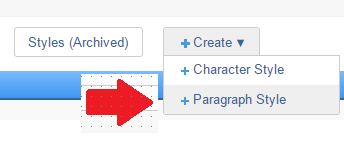
The section below describes how to configure the tabs shown in the Create ParagraphStyle dialog window.

| Name | Description |
| Name |
The name of the paragraph style. |
| Default Style? |
When enabled, this is the default paragraph style for the system. |
Character
The character styles for the paragraph are configured in the tab shown below.
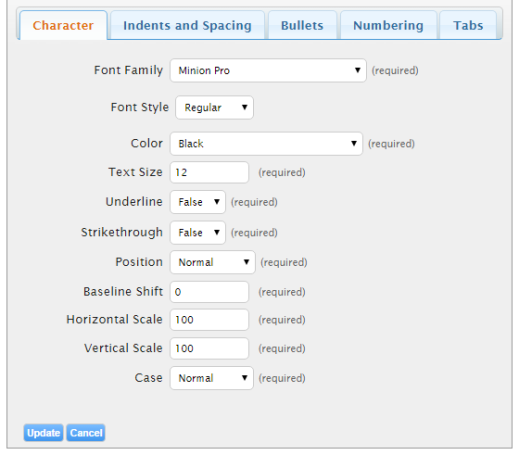
| Name | Description |
| Font Family |
The font family for the paragraph style. |
| Font Style |
The font style for the paragraph style. |
| Color |
The color of the font. |
| Text Size | The size of the font. |
| Underline | Select "True" to underline the font. |
| Strikethrough | Select "True" to add a strikethrough to the font. |
| Position |
Options available are:
|
| Baseline Shift | The value which would move the character up or down relative to the baseline of the surrounding text in the font. |
| Horizontal Scale | The value which would change the horizontal size of the selected text in the font. |
| Vertical Scale | The value which would change the vertical size of the selected text. |
| Case | The case of text (Normal, All Caps, Small Caps). |
Indents and Spacing
Configuration fields for the indents and spacing options are shown below.

| Name | Description |
| Line Height Mode |
"Auto" allows you to configure the line height as a percentage and "Unit" allows you to configure the line height in points. |
| Line Height |
If the line height mode is "Auto", input the line height as a percentage. If the line height mode is "Unit", input the line height as a point value. |
| Text Align |
The alignment for the text in the paragraph. |
| Text Indent (points) | The value for the start of the indent for the text. |
| Paragraph Start Indent (points) | The value for the start of the indent for the paragraph. |
| Paragraph End Indent (points) | The value for the end of the indent for the text. |
| Paragraph Space Before (points) | The value for the space before the paragraph. |
| Paragraph Space After (points) | The value for the space after the paragraph. |
Bullets
Configuration fields for the bullets option is shown below.
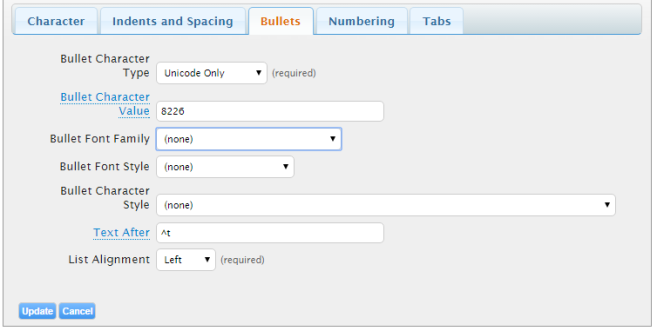
| Name | Description |
| Bullet Character Type |
Choose the character type that will be used for the bullet:
|
| Bullet Character Value |
If the bullet character type is unicode, input the decimal Unicode value. If the bullet character type is glypth, input the CID/GID value. |
| Bullet Font Family |
The font family for the bullet. |
| Bullet Font Style | The font style for the bullet. |
| Bullet Character Style | The character style for the bullet. |
| Text After | Input the text will appear after the bullet. InDesign metacharacters may be used, such as ^t for a tab character. |
| List Alignment |
Options available are:
|
Numbering
Configuration fields for the numbering option is shown below.
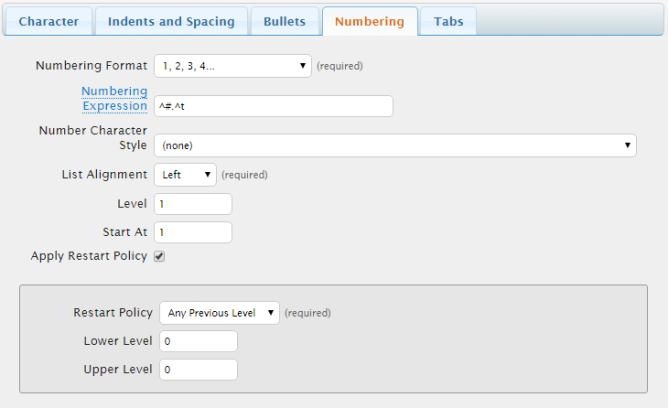
| Name | Description |
| Numbering Format |
A numbering style for the paragraph. |
| Number Expression | The numbering text that is used for each list item. Use InDesign metacharacters such as ^# for the current Level number, ^t for tab, ^1 for the Level 1 number, etc. |
| Number Character Style | A list of character styles for the numbering layout. |
| List Alignment | The alignment for the numbering layout. |
| Level | The starting level for the numbering layout. |
| Start At | The starting number for the numbering layout. |
| Apply Restart Policy |
This controls the circumstances where the numbering of a list will be restarted to its Start At number based on the previous paragraph's numbering Level.
|
Tabs
Configuration fields for the tab option is shown below. Bullets and Numbering that use the ^t InDesign metacharacter will use the first tab in the list.
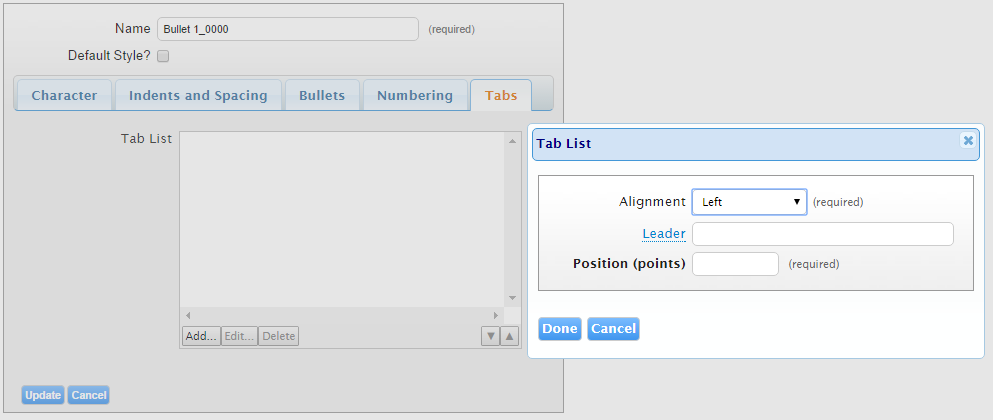
| Name | Description |
| Alignment |
The alignment of the text following the tab. |
| Leader |
A repeated pattern of characters, such as a series of dots or dashes, between a tab and the following text. |
| Position (points) |
The position in the paragraph of the start of the text after the tab. For bullets and numbering, this can be used to adjust the space between the bullet or number and the start of the list item. |
